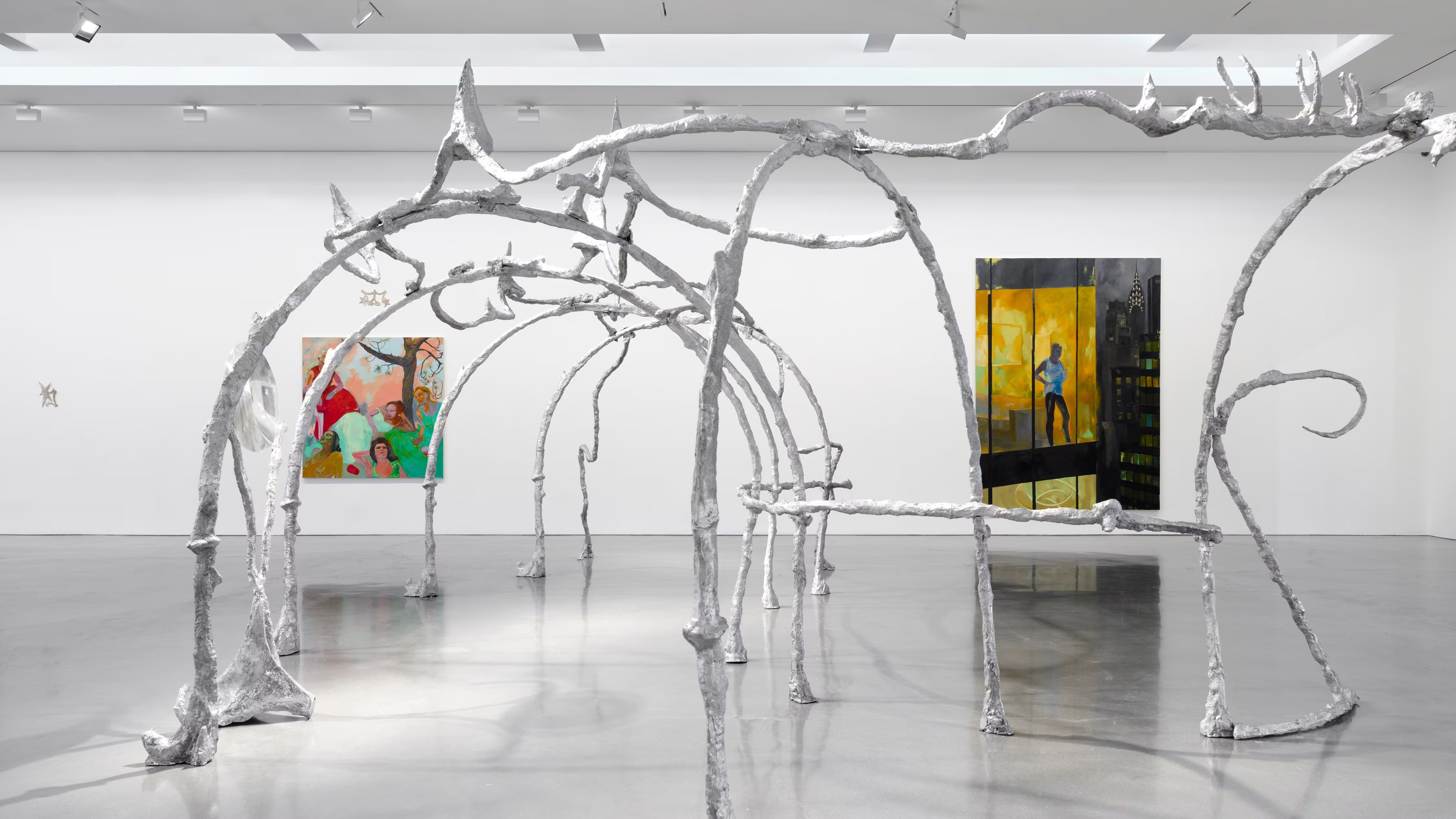
Precious Okoyomon is mid-call as I slip into their Porsche Cayenne. Their jet-black hair is slicked down, and a coffee-brown bodysuit clings to their frame under an oversize chocolate-colored jacket. Gravity, their 3-year-old familiar, curls into my lap with instinctive tenderness. His body nuzzles against me as his parent deftly weaves through traffic.
We’re teetering on the edge of lateness for an SLT Pilates class, but neither of us is particularly rushed. First, we stop to drop off Gravity with Diamond Stingily, Okoyomon’s close friend and fellow artist. The handoff is seamless, like a ritual of practiced trust. Back in the car, Okoyomon dives into another call, this time with the team at Kunsthaus Bregenz in Austria, where they will open a solo exhibition early this year. Their conversation flutters between measurements, budgets, moonshots, and most wildest dreams—a backstage glimpse into the alchemy of crafting an exhibition. I try not to eavesdrop, but it’s all too tempting.
As a curator, I savor these moments—the raw, electric in-betweens when an idea develops from its ephemeral beginnings to something tangible. Okoyomon is a master of this process, moving between imagination and execution with a boldness that few could imagine. “This will be my only major project next year,” they tell me once off the line. “I’m trying to put some time and energy into staying still.” It’s a startling statement, especially for someone like Okoyomon, whose prolific career has been a whirlwind of motion and emotion.

Okoyomon has carved out a singular space in the art world over the past decade. Their orbit extends far beyond the confines of galleries, academia, publishing, museums, and biennials into something more elemental—artist, poet, philosopher, and chef. Born in London and raised between Lagos, Houston, and West Chester Township, Ohio, they have realized a practice that is deliberate yet serendipitous, held together by an unshakable throughline: aliveness.
To hear them speak of stillness feels like receiving a family recipe on a wizened Post-it note. In the years we have orbited each other, it has always been in a beautiful storm of chaos, pleasure, and pre-rolls—a dynamic energy that I believe has shaped our respective success. And yet, during our conversation, they reveal a deeply intentional morning routine that anchors their life. “I have to have my rituals. If I don’t have them, I kind of fall apart,” they say. “I need my bath; I need my prayers. I also have to have six books of poems with me no matter where I am in the world. I need to lay and think about things, and then I’m fully back in my body. I need to stretch, and I need my Pilates routine.” For an artist so attuned to flowering and evolution, stillness itself materializes as a profound act of creation.

I think back to the past year—a kaleidoscope of projects, each reflecting Okoyomon’s boundless energy and expansive vision. Among them, their most recent triumph: a multi-day series of talks and events they helped organize for Carrie Mae Weems’ “The Shape of Things” at Gladstone Gallery. Last September in Paris after their residency at the Académie des Beaux-Arts, we sat down to chat about this very project. Their relentless pursuit of knowledge, their voracious curiosity, is something I’ve always admired. But it’s more than that. The scale of the project, set against the backdrop of an impending U.S. election, feels, frankly, punk rock. While many were overwhelmed by uncertainty, Weems and Okoyomon curated intentional space for spirits to gather and process. Their programming culminated in a marathon reading on Election Day that served as a balm. The event brought together an extraordinary roster of voices: Tina Campt, Linda Yablonsky, and Eileen Myles, a sound bath led by James Allister Sprang, and seven unique performances by both established and yet-to-be-discovered artists.
The structure—a bacchanal of ideas, sounds, and performances—calls to mind The Infinite Conversations, 2019, or the Brutally Early Club, initiatives helmed by Okoyomon’s mentor and close friend Hans Ulrich Obrist. Much like those projects, this event wasn’t just an artistic endeavor but a testament to the power of communal thought and collective creativity.
We arrive at SLT to find the class already in motion. Luckily, their late policy is ADHD-friendly, and we hop onto our reformers without hesitation. The room vibrates with effort: Commands from the instructor slice through the air, and pop music drowns out the labored breathing. Okoyomon is already in a flow state. Their movements are fluid and precise, a portrait of grace and grit. For them, fitness is no casual pursuit but a deliberate act of embodiment, a way to confront the self with care and discipline. Meanwhile, I—a self-proclaimed wellness girlie—cling to the reformer for dear life, marveling at how seamlessly they embody this balance. Even my most competitive instincts give way to admiration.

“It’s always some type of harmonious chaos,” they muse after class. “Everything is constantly figuring itself out, and then it just falls into place.” It’s a philosophy that seems to govern Okoyomon’s life, work, and worldview.
As an undergraduate at the Shimer Great Books School in Chicago, Okoyomon studied pataphysics—the philosophy of the imaginary or the unreal. This foundation underpins Okoyomon’s many wisdoms, allowing them to move through conversations with fluidity and depth. They reference philosophers like Bracha L. Ettinger, Jacques Lacan, and others with an ease and, as always, I’m taking notes on what to Google after our hang. They suggest reading Ettinger’s essay “Fragilization and Resistance,” an essay on human vulnerability, subjectivity, and the ethics of connection. Ettinger writes, “Resistance is a working for, not against: a re-working for trust, again and again… openness depends on this re-working, re-trusting, re-specting. Resistance reaches an ethical level when compassion becomes a perspective—a value.”
This sentiment resonates deeply with Okoyomon. “I pray constantly that I’m never afraid of myself or of other people,” they say, their tone deliberate. “I’m trying to make spaces where we can really know each other.” In a world shaped by callous individualism, this commitment to softness, trust, and respect is its own form of resistance: a quiet yet radical praxis of staying human.
Between 2021 and 2022, Okoyomon’s installation Every Earthly Morning the Sky’s Light touches Ur Life is Unprecedented in its Beauty transformed the Aspen Art Museum’s rooftop into a living ecosystem. The work grew, decayed, and evolved over time—a meditation on impermanence and humanity’s fragile relationship with the natural world. Over 18 months, Okoyomon collaborated with local growers to cultivate invasive plants like kudzu and honeysuckle alongside indigenous dandelions, mugwort, and milk thistle. The installation became a site for reflection, sparking conversations about literal ecosystems and the ways art can fall flat in these dialogues.

During the installation’s run, Okoyomon frequently visited Aspen to refine their ideas with a level of precision and care that mirrors their philosophies. “I like when things are slow, and I'm also so famous for a long, late meal,” they share. “My favorite is when people come over for dinner, and I really start cooking at 8 o'clock. We really have dinner at 10. It goes till 1, and I'm like, ‘Yeah, we're having ice cream and digesting in the red light.’” We riff on the shared principle that all meals are an opportunity for ceremony and moving with intention.
To begin to understand Okoyomon’s artistry fully, you must first make room for their prowess as a chef. Their love of food was born at their mother’s feet, where they learned to cook. As the oldest daughter in an immigrant household, what began as an obligation softened over time into a deeply personal passion. “I have crazy knife skills,” they say. “I learned flavor very young because many complex Nigerian flavors are fermented.” Now, Okoyomon cooks professionally as part of the collective Spiral Theory Test Kitchen, and for their studio.
In the hours before our hang, Okoyomon packed bento boxes with brown rice, brown butter leeks, and chanterelles, seasoned with black salt, dashi, and shiso, and topped with grilled salmon for their team as they prepared for the exhibition in Austria. The Kunsthaus Bregenz is most known for its exhibition history that has historically trended towards mid-career artists like Valie Export, Theaster Gates, and the late Lawrence Weiner. When Okoyomon was invited to exhibit there four years ago, they became one of the youngest artists in the museum’s history to receive this opportunity. Yet it’s not the list of names that intrigues—it’s how natural it feels that Okoyomon is amongst them. Though their chronology may be more brief than the others, their horizon of creativity is expansive.
Their work, like their life, exists in the spaces between: softness and rigor, intention and intuition, the immediate and the eternal. It makes sense. Okoyomon doesn’t just inhabit these spaces—they settle into them and invite others to find each other.









.avif)








.avif)


_result_result.avif)



.avif)

_result_result.avif)

_result_result.avif)
.avif)

_result_result.avif)


_result_result.avif)


.avif)




.webp)

.avif)















%20(1).avif)
.avif)




.avif)












.avif)


.avif)





















.jpeg)

.avif)

_11%20x%2014%20inches%20(2).jpg)







.avif)

.jpg)

%20(1).jpg)
.avif)
.jpg)

.jpg)
.webp)


.webp)



.webp)


.webp)


.avif)












.avif)
.avif)


.avif)











.avif)



.avif)




















-min_result.avif)









.avif)







3_result.avif)
_result.avif)






_result.avif)




.avif)




.avif)













_result.avif)




%2520(1)_result.avif)
_result.avif)


_result.avif)

_result.avif)
.avif)

.avif)







.avif)

.avif)










.avif)



.avif)


_result_result.avif)
















-min_result.avif)






.avif)
.jpg)
















_result.avif)

.avif)


.avif)







.avif)





.avif)

_result.avif)



.avif)







.avif)









.avif)


.avif)














.avif)




.avif)








.avif)

.avif)

.avif)



.avif)


.avif)




.avif)

.avif)

.avif)
.avif)
%20(1).avif)
.jpg)

%20(1).avif)








.avif)
.avif)

.avif)






.avif)


.avif)
.avif)



.avif)
.avif)


















.avif)
.avif)
